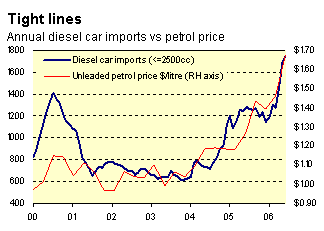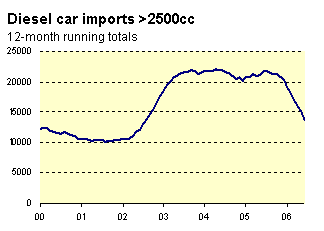Diesel fashion
The Audi A10’s win at this year’s Le Mans 24 hour endurance race was the most significant victory yet for a diesel-powered car in a major racing event. Moreover, not only did the Audi win, but it was also the cleanest and quietest car in the race. Diesels are also enjoying success off the track. Underpinned by lower running costs, diesel cars’ popularity in Europe is now such that they are expected to out-sell new petrol cars during 2006.1
While still very much a niche market in New Zealand (new diesel imports in the year to June amounted to only 5.3% of total new car sales in the same period), diesel cars have experienced a sharp rise in popularity in recent months. Imports of new diesel-powered cars with an engine capacity of less than 2500cc2 over the six months to June were up 112% on the same period in 2005, while imports in the June quarter were 200% higher than a year ago.
SUV’s aside, diesel-powered cars have proven far less popular in New Zealand than in other countries in the past. But the introduction of cleaner diesel, improvements to diesel engine performance and $1.70/litre plus for regular petrol appear to be changing our attitude toward the oft-maligned noisy stinkers.
Sorry, did you say a diesel?
Part of the explanation for the lack of diesel car penetration here is due simply to the dearth of new diesel passenger cars on offer. Of the top five new car distributors in 2005 (Toyota, Ford, Holden, Honda, and Mitsubishi — which collectively accounted for 60% of the market), only Holden is currently offering a diesel-powered passenger car – the Astra 1.9 turbo diesel.
Petrol’s up, better get a diesel
The graph below demonstrates the close relationship between petrol prices and demand for diesel cars.

Although rising fuel prices are a major factor in their increased popularity, improvements in the quality of diesel sold in New Zealand have also spurred diesel sales. With higher quality diesel meeting the specifications of new-technology diesel engines, local dealers have been able to import models that incorporate the improvements made to diesel power plants in recent years. The improved performance, noise, and emission attributes of the latest diesel engines has reduced the "trade-offs" previously associated with owning a diesel car. Imports of new diesel cars (maximum engine capacity of 2,500cc) lifted sharply after the introduction of diesel with a sulphur content of 500ppm in mid 2004, and then again at the end of 2005, when the standard was tightened to 50ppm.
As with cars generally, larger diesel cars (engine capacity greater than 2,500cc), have become less popular. Large car sales in general have declined from 23.7% of the new car market in 2000 to just 10.5% in June 20063, while imports of both new and used large diesel cars have fallen steadily over the first half of this year.

Less pain at the pump
The Automobile Association has conducted tests measuring the relative running costs of diesel and petrol cars. The fuel economy for the petrol and diesel cars in their sample with engine capacities below 2000ccs was 6.9 and 8.9 litres per 100 km/s, respectively. Similarly, the larger diesel cars (cc rating exceeding 2000) in their sample also had better fuel economy than their petrol counterparts — 10.3 litres per 100kms versus 11.1. Using an unleaded petrol price of $1.77 and a diesel price of $1.25, and including road user charges (RUC) of $0.03 per kilometre, the relative costs of like diesel and petrol cars can be summarised as follows:

On a per kilometre basis the fuel cost savings for smaller diesel cars is $345 per 10,000 km/s, or $3,450 per 100,000 km/s. For larger diesels the difference is $3,630 per 100,000 km/s. On a straight fuel economy basis, therefore, there are clear advantages in owning a diesel car. Interestingly, the AA found that when maintenance and fixed costs are taken into account, the premium (up to $9000 in their sample) placed on new diesel models makes petrol cars the more cost effective option (this gap is closing on many models, however).
Bright prospects
While the 50% market share currently enjoyed in Europe is a long way off here, the popularity of diesel cars in New Zealand is likely to maintain its recent upward trend. The improvements being made to diesel technology will assuage performance concerns, and in doing so, highlight the fuel efficiency benefits of diesel cars. The small end of the market in particular is an area where the fuel economy benefits of diesels will have the most appeal to fuel-cost conscious consumers.






